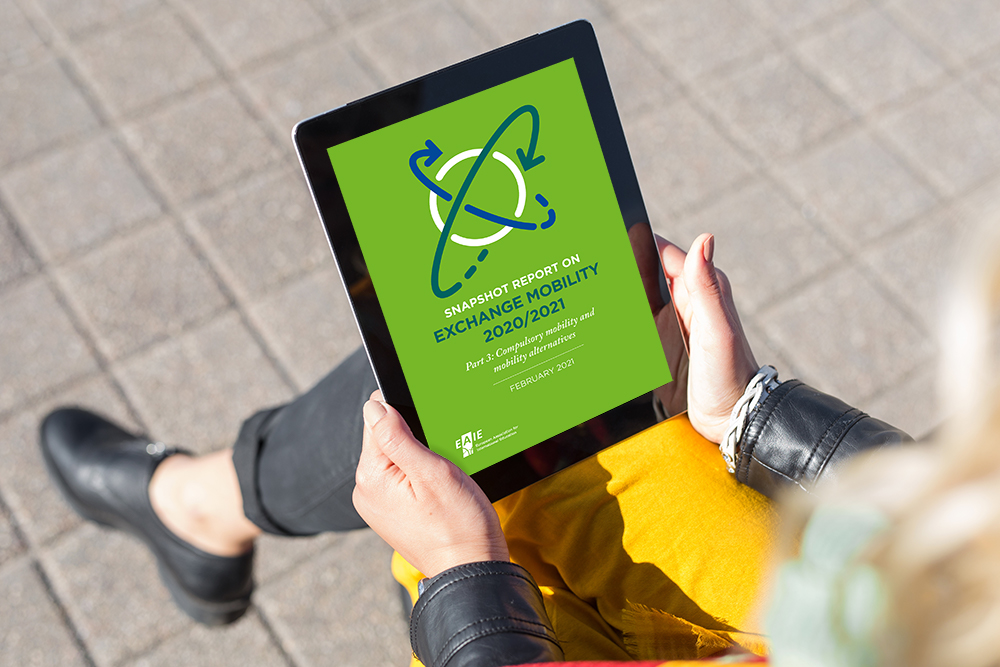Part 3 of new EAIE report: Compulsory mobility and mobility alternatives

The disruptions to student exchange mobility have been significant during the current academic year, as evidenced by the two previously released parts of the EAIE series Snapshot report on exchange mobility 2020/2021. Whereas the first two parts in the series looked at student exchange dynamics involving Snapshot report on exchange mobility 2020/2021: Part 1 (EHEA) and Snapshot report on exchange mobility 2020/2021: Part 2, the third and final instalment in this report series offers a different set of insights.
Specifically, Part 3 puts a spotlight on the effects that travel limitations have had on compulsory mobility, ie for students obligated to undertake a mobility experience as a course or programme requirement. It also explores the alternatives to mobility that institutions have offered or perceive their students to have elected in the face of travel disruptions.
The EAIE Snapshot report on exchange mobility 2020/2021 draws on data that was collected from higher education institutions across the European Higher Education Area (EHEA) via an online survey in October and November 2020. The primary goal was to gather details about how inbound and outbound exchange student numbers – within the EHEA as well as with non-EHEA partners – were looking at the start of the current academic year, as opposed to a ‘typical’ academic year. Respondents were also asked to forecast how they expected student mobility flows to look in early 2021. Specific to Part 3 in the series, the survey additionally sought to ascertain how compulsory mobility dynamics were being affected during this academic year, and the ways in which institutions and students were engaging with alternatives to mobility.
Compulsory mobility: not a niche phenomenon
The imposition of a mobility requirement on at least some students appears not to be an anomaly among the survey respondents as a group. Indeed, nearly 50% of the 366 respondents to the survey question about the existence of compulsory mobility at their institution indicated that some students were subject to a mobility requirement. Though significantly less common in Western Asia and Southern Europe than in other regions, the existence of some compulsory mobility was strongly evident (to the tune of 40–58%) across all four of the institutional types addressed in the survey.
Nearly 20% of respondents indicated that the lack of ability to undertake compulsory mobility could have very serious consequences for students’ progression
As with the findings from the previous two Snapshot reports, mobility opportunities even for those students facing compulsory study abroad have been significantly undermined during the 2020–2021 academic year. A full 59% of respondents indicated a decrease in numbers of their students undertaking required mobility experiences for the full year or semester 1, and 48% expected to see decreases among these numbers in semester 2. Importantly, nearly 20% of respondents indicated that the lack of ability to undertake compulsory mobility could have “very serious” consequences for students’ progression through their academic programmes.
What to do when mobility isn’t an option?
In support of students facing obstacles to compulsory mobility, respondents indicated that their institutions were offering a variety of substitute experiences and work-around arrangements. The options offered by institutions that respondents most frequently mentioned include ‘virtual mobility’, postponement of mobility to a later date, and alternative intercultural experiences in the students’ local environments.
Whether students are subject to compulsory mobility or opt for mobility out of personal interest, mobility obstacles during this academic year have forced them to consider a variety of alternatives. With some variations in terms of whether the mobility involved exchanges with EHEA or non-EHEA partners, the survey respondents indicated that the ‘first choice’ alternatives to physical mobility most often selected by students included postponement of mobility to a later date, cancelling or forgoing the mobility experience altogether, or changing their mobility destination. Interestingly, virtual mobility/online engagement was very infrequently cited as a first-choice alternative to mobility that respondents saw students opting for.
EAIE members can click the button below to download the full report for free and non-members can view Snapshot report on exchange mobility 2020/2021: Part 1 for a preview of what the data is telling us about the current state of exchange mobility.
